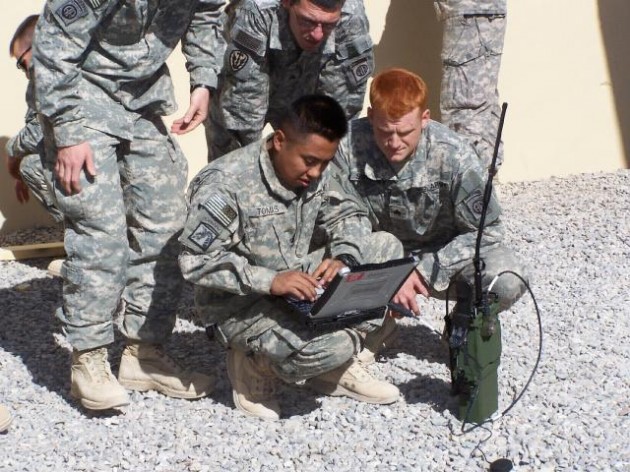Will US Pursue ‘Enhanced Human Ops?’ DepSecDef Wonders
Posted on

WASHINGTON: The Defense Department’s Third Offset Strategy is designed to create new advantages over adversaries now that Russia and China are developing stealth fighters, cyber weapons, and precision missile arsenals of their own. With studies well underway and up to $15 billion budgeted for experimentation in 2017, the emerging answer is a cluster of technologies related to artificial intelligence.
But that advantage is not likely to last long, Deputy Defense Secretary Bob Work warns. Since the revolution in artificial intelligence and robotics is being driven by the commercial sector, and software crosses borders easily (legitimately or not), it’s entirely possible for the Russians and Chinese to exploit the same technologies we do, Work said. In fact, their more flexible ethics may allow them to exploit technologies we don’t.

German Panzers cross the Ardennes to take French forces by surprise, 1940.
The Authoritarian Alternative
When the Defense Department launched the “Second Offset” — precision guided weapons, stealth, and networks — circa 1975, “we knew the Russians, the Soviets, couldn’t follow,” Work said. Today, “we can’t make that assumption,” he said. “This is much more like the interwar period” — between 1919 and 1939, when the Germans developed blitzkrieg while the US and Japan led on aircraft carriers — when all the technologies were available to anyone, and the advantage went to whoever put the pieces together best
In at least one area, our adversaries are ahead: enhancing human performance by modifying the body and brain itself. “Now our adversaries quite frankly are pursuing enhanced human operations and it scares the crap out of us, really,” Work said. “We’re going to have to have a big, big decision on whether we’re comfortable going that way.” So far, the US military has focused on better equipment for the human — heads-up displays, wearable electronics, better body armor, maybe even exoskeletons — rather than upgrading the human being him- or herself.

Robert Work
Even when adversaries pursue the same technologies as we do, their values mean they may pursue them very differently. “China’s investing heavily in robotics and autonomy, and the Russian chief of General Staff, [Valeriy] Gerasimov, recently said that the Russian military is preparing to fight on the roboticized battlefield, and he said, I quote, ‘in the near future it is possible a fully robotized unit will be created capable of independently conducting military operations.'”
The idea of roving Russian robo-tanks is the stuff of sci-fi nightmares. In the US military, “we believe strongly that humans should be the only ones to decide when to use lethal force,” Work emphasized. “[But] authoritarian regimes who believe people are weaknesses in the machine…. they will naturally gravitate towards totally automated solutions,” Work said. “Why do I know that? Because that’s exactly the way the Soviets [conceived] their recon-strike complex; it was going to be completely automated.”
By contrast, the US offset strategy is all about empowering humans with machines, not replacing them. As impressive as computers can be, after all, every mammal is the product of hundreds of millions of years of evolution in which anyone who didn’t react effectively to threats got eaten. That means human beings still bring something to the battlefield.
Computers will help humans sort through masses of data, react to threats moving too fast for human reflexes, and control automated wingmen or weapons — but the humans will always be making the larger decisions. That centaur-like synergy of machine speed and human insight, Work feels, will provide a crucial advantage over adversaries who rely on either alone.

Gen. Mark Milley
Making It Happen: Up To $15 Billion In FY17
“In this environment there will be a lot of fast followers; I’m okay with that as long as we’re a fast leader,” Work said. “If people are chasing our exhaust, that’s okay with me.”
At this stage, though, the offset strategy is less about making anyone chase our exhaust and more about designing the car. Work has his hypotheses about what technologies and tactics will work, but they’re still in the testing stage, he emphasized.
“Don’t expect in the ’17 budget to see $30 billion in this,” Work said. “What you’re probably going to see is closer to the order of $12 to $13 to $15 billion [for] wargaming, experimentation, and demonstrations.” Only in subsequent years will the technologies that prove out get substantial funding — if it can be found.
“There are lot of potential technologies” that could be “accelerated” into the field, the Army Chief of Staff, Gen. Mark Milley, said after Work’s speech at the CNAS conference. The Army is already pioneering manned-unmanned teaming between its AH-64 Apache attack helicopters and Grey Eagle drones, he noted. Future advances in information technology could lead to smaller, more deployable command posts or convoys of self-driving trucks.
“There are some things out there that do exist and we could use them even in the near term,” Milley said. “There’s things being done today in robotics, for example, that have great promise to be used on battlefields, and we could accelerate some of that.”
But “acceleration” isn’t free, and needs like personnel costs and combat readiness have to take priority, Milley said. “The problem with the modernization piece is not so much the technologies or the ideas. The problem is money,” he said, rubbing his fingers together. “The modernization accounts, the S&T [science and technology]-type accounts over the last many years, for the Army, have been underfunded significantly.”

Army soldiers train with a PRC-117G digital radio in Afghanistan.
The Human Dimension
Adversaries catching up to our technology isn’t the only concern. Even America’s much-vaunted advantage in the quality of its people may not be the enduring advantage we hope it is.
“Look, I’m not willing to say we will have an enduring advantage in human capital over the course of this competition,” Work said. “I believe we have a marked advantage as we start.”
“I will put the innovation of this armed force against any fricking other force on the planet!” Work declared. ” And we will ride that for a good period of time. [But] if they start to really say, ‘we want to empower our junior leaders, we’re willing to let them make mistakes, we’re going to let them try innovation and fail’ — if they can do that better than us — that’s a problem.”
In fact, though Work didn’t say so, there is a definite historical precedent for the forces of an authoritarian state being more innovative, adaptable, and decentralized than their democratic opponents. Imperial Germany invented “infiltration tactics,” the basis of all modern ground tactics, in World War I. Operating on their own initiative, small teams of stosstruppen — stormtroopers — slipped through gaps in the rigid defense lines of the French and British, finally breaking the stalemate of trench warfare, albeit too late to win the war. Nazi Germany put infiltration tactics on tank treads, with radio communications and air support. The result was the blitzkrieg, which literally drove circles around the hidebound commanders of democratic France and Britain. (This innovation, along with the development of aircraft carriers, radar, and other new tactics and technologies, is often called a Revolution in Military Affairs). In short, a country that brutally suppressed political dissent still managed to encourage initiative and innovation in military matters.
China and Russia haven’t reached this state. Perhaps they never will. For now, Work certainly believes the human element is not only a crucial American advantage but is also essential to making full use of the non-human elements of the offset strategy.
“The theme that came out over and over again was what we call human-machine collaboration and combat teaming,” Work said. “AI and autonomy will allow entirely new levels of man-machine symbiosis, letting each do what they do best.”
Subscribe to our newsletter
Promotions, new products and sales. Directly to your inbox.
